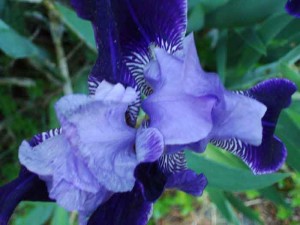ABOUT COLOUR: VIOLET
About Violet
Red-violet connotes spiritual love. In purple (reddish violet), the colour of the cardinals, temporal and spiritual power is united. As the opposite of yellow, consciousness, violet represents unconscious – mysterious, impressive, and sometimes oppressive, now menacing, now encouraging, according to contrast. When violet covers large regions it can be frightening. Primarily, all tints represent the brighter qualities of life, whereas shades symbolize the dark and negative forces.
In nature many plants have light violet shoots with yellow centres.
Many of our fruits, vegetables, gemstones and minerals are violet such as eggplants, beets, purple cabbage, grapes, lilacs, irises, lavender, and amethyst mineral, purple garnet, sapphire, opal and topaz.
Violet is the hue synonymous with devotion, piousness, religion, holiness, saintliness, reverence, justice, sensuality, shadows, solitude, splendor, truth, superstition, majesty, and magic. In the other side of the coin violet represents arrogance, exaggeration, dishonesty, sorrow and secrecy.
Violet in Different Cultures
- In Europe: Red-violet has been the colour most associated with royalty. It is still used by the British Royal Family and other royalty in Europe as a ceremonial colour on special occasions.
- Britain: Red-violet (purple) is sometimes associated with mourning.
- China: Red-violet represents spiritual awareness, physical and mental healing, strength and abundance. It also symbolizes luck and fame. It represents nobility. In Chinese painting, this colour represents the harmony of the universe.
- Japan: Red-violet represents privilege and wealth, the colour associated with the Japanese aristocracy.
- India: Reincarnation.
- Thailand: Widows in mourning wear violet.
- Brazil: Purple is the colour of mourning.
- Egypt: The colour purple is the colour of virtue.
- Catholicism: Contrition, penitence, colour of Lent
The Theory of Violet
- Violet is a secondary colour located midway on the colour wheel between the primaries red and blue.
- Violet is opposite yellow on the the colour wheel.
- It is also sandwiched between blue-violet and red-violet.
- It’s character of expression changes depending on the ratio of these primaries in the mixture. This ratio will reflect its colour temperature.
- The range of modulation is very broad as violet is the darkest hue on the colour wheel. Add white to violet and this hue will extend to a wide range of tints and values. Add black to violet for a wide range of violet shades.
- Add violet’s complement, yellow, and you will get various transitional tones between light yellow and dark violet.
- Cobalt violet was used by artists Paul Signac, Claude Monet and Georges Seurat. Vincent van Gogh was very knowledgeable on colour theory and he used violet in many of his paintings including his paintings of irises and the swirling and mysterious skies of his starry night paintings. He often combined it with it’s complementary colour, yellow.
Do check out my website at www.donnawilsonartist.com

